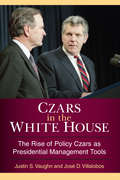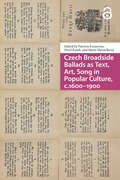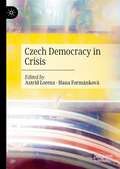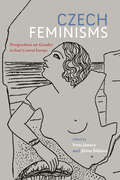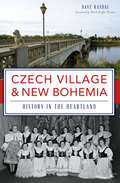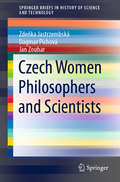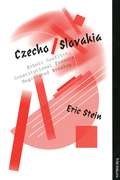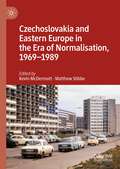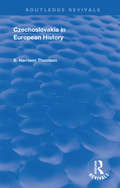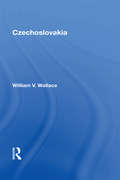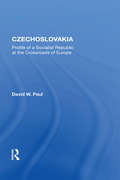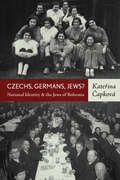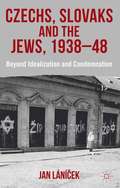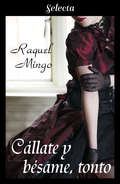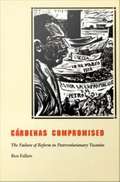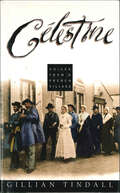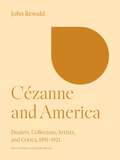- Table View
- List View
Cyrus the Great: A Biography of Kingship (Routledge Ancient Biographies)
by Lynette MitchellCyrus the Great was a celebrity of the ancient world, the founder of one of the first world empires in the ancient Near East, whose life and deeds were celebrated through the many stories told about him, then and for millennia. This book offers an analysis of these stories, locating them within the rich storytelling cultures of the ancient Mediterranean and the Near East. Although there are few fixed points in Cyrus’ career, it is possible to see through these narratives the way his kingship developed so he became not just the instrument of the gods, but also their companion. Mitchell explores what these stories reveal about the different societies and cultures who engaged with the mythology surrounding Cyrus in order to examine their own conceptions of great men, leadership, kingship, and power. Such was his celebrity in antiquity that the stories about his kingship have remained influential over the course of two and a half thousand years into the modern era. Cyrus the Great: A Biography of Kingship is of interest to students and scholars studying the Achaemenids and ancient kingship, particularly as it is depicted in the literary and historical traditions of the ancient Near East, as well as those working on the Near Eastern world more generally. Scholars of Greek history in this period will also find much to interest them.
Czars In The White House: The Rise Of Policy Czars As Presidential Management Tools
by Justin S. Vaughn Jose D. VillalobosWhen Barack Obama entered the White House, he faced numerous urgent issues. Despite the citizens' demand for strong presidential leadership, President Obama, following a long-standing precedent for the development and implementation of major policies, appointed administrators--so-called policy czars--charged with directing the response to the nation's most pressing crises. Combining public administration and political science approaches to the study of the American presidency and institutional politics, Justin S. Vaughn and José D. Villalobos argue that the creation of policy czars is a strategy for combating partisan polarization and navigating the federal government's complexity. They present a series of in-depth analyses of the appointment, role, and power of various czars: the energy czar in the mid-1970s, the drug czar in the late 1980s, the AIDS czar in the 1990s, George W. Bush's trio of national security czars after 9/11, and Obama's controversial czars for key domestic issues. Laying aside inflammatory political rhetoric, Vaughn and Villalobos offer a sober, empirical analysis of what precisely constitutes a czar, why Obama and his predecessors used czars, and what role they have played in the modern presidency.
Czars and Shoguns: Early Russia and Feudal Japan (Core Knowledge History and Geography)
by Core Knowledge FoundationFrom the CORE KNOWLEDGE FOUNDATION, which brought you the popular "What Your ___ Grader Needs to Know" series. CZARS AND SHOGUNS: EARLY RUSSIA AND FEUDAL JAPAN is a single volume divided into two separate sections on (1) Early Russia, and (2) Feudal Japan. The first section tells the story of how Russia grew to a large country ruled by powerful czars, including Ivan III (the Great), Ivan IV (the Terrible), Peter the Great, and Catherine the Great. The second section explores Japan's geography as an island nation and traces the rise of powerful feudal leaders called shoguns, and the role of the soldier-nobles called samurai. Chapters explore how Japan remained closed to most outsiders until European powers compelled the Japanese to open their doors for trade. The book also introduces two important religions in Japanese history, Buddhism and Shinto. Paperback. 102 pages. ** Part of the CORE KNOWLEDGE HISTORY AND GEOGRAPHYTM (CKHG) series in world and American history and geography, integrating topics in civics and the arts. CKHG books offer engagingly written text with many color illustrations, maps, vocabulary sidebars, and a glossary. Related materials (Teacher Guides and Timeline Cards) are also published by the Core Knowledge Foundation. In general, CKHG books are appropriate for young readers from the upper elementary grades through middle school.
Czech Broadside Ballads as Text, Art, Song in Popular Culture, c.1600–1900
by Patricia Fumerton Pavel Kosek Marie HanzelkováThis landmark collection makes a major contribution to the burgeoning field of broadside ballad study by investigating the hitherto unexplored treasure-trove of over 100,000 Central/Eastern European broadside ballads of the Czech Republic, from the 16th to the 19th century. Viewing Czech broadside ballads from an interdisciplinary perspective, we see them as unique and regional cultural phenomena: from their production and collecting processes to their musicology, linguistics, preservation, and more. At the same time, as contributors note, when viewed within a larger perspective—extending one’s gaze to take in ballad production in bordering lands (such as Germany, Poland, and Slovakia) and as far Northwest as Britain to as far Southwest as Brazil—we discover an international phenomenon at work. Czech printed ballads, we see, participated in a thriving popular culture of broadside ballads that spoke through text, art, and song to varied interests of the masses, especially the poor, worldwide.
Czech Democracy in Crisis
by Astrid Lorenz Hana Formánková"Democracy theories and comparative political science have been challenged within the last decade by an unexpected democratic deficit and the rise of populism in the new EU-member states. This volume written by German and Czech scholars gives some food for thought for solving these research problems by means of thorough analyses of the polity, the politics and selected policies of the Czech Republic since 1990."Dieter Segert, retired Professor of Political Science (Area Studies on Eastern Europe), University of Vienna, Austria"Czech Democracy in Crisis is a long-overdue comprehensive study of the Czech political system. Using institutional approaches to change, it explores crucial policy outcomes. A perfect book for academics and practitioners who want to understand the challenges of democratic consolidation in a new democracy."Lenka Bustikova, Associate Professor of Political Science, Arizona State University, USA, and author of Extreme Reactions: Radical Right Mobilization in Eastern EuropeThe image of the Czechs as a poster child of democratization has changed into a crisis narrative in recent years. This edited volume traces this change and examines the suitability of different theories to explain developments in Czech democracy. The contributors, all renowned experts in their fields, offer well-founded and compact insights into the post-1989 Czech political system. They cover political institutions and parties; civil society; the media; and selected policy areas such as foreign, economic, migration and regional policy. The book takes into account processes of democratization and Europeanization, explaining the political picture at various stages of development. Finding that many of today’s problems—fragmented political parties, government instability, inefficient state administration and low quality of governance—have not been new developments but have constantly existed, the authors present a plea for theoretical adjustments that should be read by all academics, students, practitioners and readers with an interest in Czech politics and society.
Czech Drama Since World War II: Czech Drama Since World War Ii (1978) (Routledge Revivals)
by Paul I. TrenskyDuring the years between 1956 and 1970 Czech literature and theatre passed through a profoundly creative period, a renaissance or spiritual rebirth following an era of sterility that was the result of the forced imposition of the Stalinist dogma of socialist realism. This study is a first attempt, to define for us the character and originality of this era. This title was first published in 1978.
Czech Feminisms: Perspectives on Gender in East Central Europe
by Iveta Jusová Jiina ŠiklováIn this wide-ranging study of women's and gender issues in the pre- and post-1989 Czech Republic, contributors engage with current feminist debates and theories of nation and identity to examine the historical and cultural transformations of Czech feminism. This collection of essays by leading scholars, artists, and activists, explores such topics as reproductive rights, state socialist welfare provisions, Czech women's NGOs, anarchofeminism, human trafficking, LGBT politics, masculinity, feminist art, among others. Foregrounding experiences of women and sexual and ethnic minorities in the Czech Republic, the contributors raise important questions about the transfer of feminist concepts across languages and cultures. As the economic orthodoxy of the European Union threatens to occlude relevant stories of the different national communities comprising the Eurozone, this book contributes to the understanding of the diverse origins from which something like a European community arises.
Czech Refugees in Cold War Canada: 1945–1989 (Studies in Immigration and Culture #15)
by Jan RaskaDuring the Cold War, more than 36,000 individuals entering Canada claimed Czechoslovakia as their country of citizenship. A defining characteristic of this migration of predominantly political refugees was the prevalence of anti-communist and democratic values. Diplomats, industrialists, politicians, professionals, workers, and students fled to the West in search of freedom, security, and economic opportunity. Jan Raska’s Czech Refugees in Cold War Canada explores how these newcomers joined or formed ethnocultural organizations to help in their attempts to affect developments in Czechoslovakia and Canadian foreign policy towards their homeland. Canadian authorities further legitimized the Czech refugees’ anti-communist agenda and increased their influence in Czechoslovak institutions. In turn, these organizations supported Canada’s Cold War agenda of securing the state from communist infiltration. Ultimately, an adherence to anti-communism, the promotion of Canadian citizenship, and the cultivation of a Czechoslovak ethnocultural heritage accelerated Czech refugees’ socioeconomic and political integration in Cold War Canada. By analyzing oral histories, government files, ethnic newspapers, and community archival records, Raska reveals how Czech refugees secured admission as desirable immigrants and navigated existing social, cultural, and political norms in Cold War Canada.
Czech Republic (Major European Union Nations)
by Heather DocalavichThe Czech Republic is one of the newest countries in the world. It's also new to the EU--it joined in 2004. People have lived in what we now call the Czech Republic for thousands of years, however. This land has a long history and is moving forward while dealing with challenges like the recent global recession. Discover more about this exciting, modern nation!
Czech Security Dilemma: Russia as a Friend or Enemy? (New Security Challenges)
by Miroslav Mareš Jan HolzerThis volume examines the future directions of Czech international policy through an interdisciplinary analysis of both historical and current Russian-Czech relations. It analyses Czech relations with Russia based on their historical heritage underpinned by the superpower’s behaviour and interests in the Central European region. The book’s central theme is the current Czech security dilemma in which the Czech political community perceives Russia as a security threat, but also would prefer to cooperate with Russia to ensure its security. The authors give a full overview and explanation of Czech-Russian relations, while also explaining the current dilemmas within the Czech Republic’s political, cultural and economic community.
Czech Village & New Bohemia: History in the Heartland (Brief History)
by Mark Stoffer Hunter Dave RasdalBeginning in the 1870s, thousands of Bohemians flocked to Cedar Rapids in search of a better life. Czech immigrants courageously overcame the difficult conditions of the local packinghouse and the challenge of creating a new home. They maintained a strong cultural identity with Czech music, literature and an undying dedication to family. In the wake of a devastating flood in 2008, the people of Czech Village and New Bohemia re-imagined traditional principles to forge a remarkable resurgence toward a promising future. Author Dave Rasdal travels from the Charles Bridge to the Bridge of Lions in a celebration of Czech heritage and history in Cedar Rapids.
Czech Women Philosophers and Scientists (SpringerBriefs in History of Science and Technology)
by Zdeňka Jastrzembská Dagmar Pichová Jan ZouharThis book examines the most important Czech women philosophers and scientists. It highlights the lives and achievements of a group that has often not received the recognition they deserve. Chapters provide a systematic description and critical evaluation of the impact these women had on the history of philosophy and science. After an opening chapter on the status of women philosophers and scientists in the period before 1820, the book explores the role women played in the 19th century rise of Czech culture (Czech National Revival). The following chapter then introduces the situation of Czech women philosophers and scientists in the 20th century. The authors base the material on analysis of key works and the characteristics of contemporary debates in which these women participated. The volume describes the complex conditions of women in Czech history in relation to the position of learned women in other European countries. The authors also emphasize their link to the historical background. This encompassing coverage helps provide readers with a richer understanding of these important women and the period in which they lived. Academicians and the general public alike will also learn about the political and social limitations these women faced and the influence of historical conditions on their work.
Czecho/Slovakia
by Eric SteinAs the clock struck midnight on December 31, 1992, Czechoslovakia, the only genuine democracy in post-World War I Central-Eastern Europe, broke up into two independent successor states. This book explores the failed search for a postcommunist constitution and it records in a lively style a singular instance of the peaceful settlement of an ethnic dispute. For more than three years after the implosion of the Communist regime in 1989, the Czechs and Slovaks negotiated the terms of a new relationship to succeed the centralized federation created under communism. After failing to agree to the terms of a new union, the parties agreed on an orderly breakup. In the background of the narrative loom general issues such as: What are the sources of ethnic conflict and what is the impact of nationalism? Why do ethnic groups choose secession and what makes for peaceful rather than violent separation? What factors influence the course of postcommunist constitutional negotiations, which are inevitably conducted in the context of institutional and societal transformation? The author explores these issues and the reasons for the breakup. Eric Stein, a well-known scholar of comparative law and a native of Czechoslovakia, was invited by the Czechoslovak government to assist in the drafting of a new constitution. This book is based on his experiences during years of work on these negotiations as well as extensive interviews with political figures, journalists, and academics and extensive research in the primary documents. It will appeal to historians, lawyers, and social scientists interested in the process of transformation in Eastern Europe and the study of ethnic conflict, as well as the general reader interested in modern European history. Eric Stein is Hessel E. Yntema Professor Emeritus, University of Michigan Law School. He previously served with the United States Department of State in the Legal Advisor's Office. He is the author of many books and articles on comparative law and the law of the European Community.
Czechoslovakia and Eastern Europe in the Era of Normalisation, 1969–1989
by Matthew Stibbe Kevin McDermottThis edited collection represents the first comprehensive volume in English on the crucial, but under-explored, late period in the history of East European communism. Focusing on developments in Czechoslovakia from the crushing of the Prague Spring in August 1968 to the ‘Velvet Revolution’ of November 1989, the book examines a broad range of political, social and cultural issues, while also analysing external perceptions and relations. It explores the concept of ‘normalisation’ in historical context and brings together British, American, Czech and Slovak experts, each with their own archival research and particular interpretations. Overall, the anthology aims to assess the means by which the Prague Spring reforms were repealed and how Czechoslovakia was returned to a ‘normal’ communist state in line with Soviet orthodoxy. Key themes include the Communist Party and ideology; State Security; Slovak developments; ‘auto-normalisation’; women and gender; cultural and intellectual currents; everyday life and popular opinion; and Czechoslovakia’s political and cultural relationship with the USSR, the GDR, Poland and Yugoslavia. The volume sheds light on the process of decay of the Czechoslovak communist regime and the reasons for its ultimate collapse in 1989.
Czechoslovakia in European History (Routledge Revivals)
by S. Harrison ThomsonFirst published in 1943, this volume aims to trace the development of several of the more acute problems of Czechoslovak life and history in a country which has been highly sensitive to the disturbances which have shaken the rest of Europe and which has never been far from the tumult and the clash of arms. Only through historical analysis and quiet explanation of the facts can we fairly judge, in the light of past event, the ultimate value of a free Czechoslovakia to a free Europe.
Czechoslovakia/h: The Historical Road To Revolution
by Michael B WallaceCzechoslovakia only came into existence in 1918. But the history of the Czechs and Slovaks and the lands they inhabit goes back a long way. It is a history that is important for its own sake as well as for the legacy it gave the modern state and the understanding it brings to a study of present-day Czechoslovakia. It is also a history so rich in ma
Czechoslovakia: Profile Of A Socialist Republic At The Crossroads Of Europe
by David W PaulCzechoslovakia as a political entity did not come into being until 1918, but the lands comprising modern-day Czechoslovakia have a rich history reaching back many centuries. This text offers at look at the historical background, the geopolitics and Czechoslovakia’s international position, it’s government and politics, economy, education and cultur
Czechoslovakism (Routledge Histories of Central and Eastern Europe)
by Adam Hudek Jan Mervart Michal KopečekThis collection systematically approaches the concept of Czechoslovakism and its historical progression, covering the time span from the mid-nineteenth century to Czechoslovakia’s dissolution in 1992/1993, while also providing the most recent research on the subject. "Czechoslovakism" was a foundational concept of the interwar Czechoslovak Republic and it remained an important ideological, political and cultural phenomenon throughout the twentieth century. As such, it is one of the most controversial terms in Czech, Slovak and Central European history. While Czechoslovakism was perceived by some as an effort to assert Czech domination in Slovakia, for others it represented a symbol of the struggle for the Republic’s survival during the interwar and Second World War periods. The authors take care to analyze Czechoslovakism’s various emotional connotations, however their primary objective is to consider Czechoslovakism as an important historical concept and follow its changes through the various cultural-political contexts spanning from the mid-nineteenth century to the breakup of Czechoslovakia in 1993. Including the work of many of the most eminent Czech and Slovak historians, this volume is an insightful study for academic and postgraduate student audiences interested in the modern history of Central and Eastern Europe, nationality studies, as well as intellectual history, political science and sociology.
Czechs, Germans, Jews?
by KateThe phenomenon of national identities, always a key issue in the modern history of Bohemian Jewry, was particularly complex because of the marginal differences that existed between the available choices. Considerable overlap was evident in the programs of the various national movements and it was possible to change one's national identity or even to opt for more than one such identity without necessarily experiencing any far-reaching consequences in everyday life. Based on many hitherto unknown archival sources from the Czech Republic, Israel and Austria, the author's research reveals the inner dynamic of each of the national movements and maps out the three most important constructions of national identity within Bohemian Jewry - the German-Jewish, the Czech-Jewish and the Zionist. This book provides a needed framework for understanding the rich history of German- and Czech-Jewish politics and culture in Bohemia and is a notable contribution to the historiography of Bohemian, Czechoslovak and central European Jewry.
Czechs, Slovaks and the Jews, 1938–48: Beyond Idealisation and Condemnation
by Jan LáníčekCovering the period between the Munich Agreement and the Communist Coup in February 1948, this groundbreaking work offers a novel, provocative analysis of the political activities and plans of the Czechoslovak exiles during and after the war years, and of the implementation of the plans in liberated Czechoslovakia after 1945.
Cállate y bésame, tonto (El club de los seductores #Volumen 2)
by Raquel MingoLlega la segunda entrega de «El club de los seductores». La continuación de la serie romántica histórica que los lectores de Raquel Mingo estaban esperando. Una mujer indomable, un hombre sin escrúpulos y el fuego incontrolable de su pasión siempre dispuesto a devorarlos. Alexandria Sant Montiue es demasiado intrépida, rebelde y apasionada para su propio bien. Alocada y temeraria dirían algunos. Soberbia e inconsciente, le reprocharían otros. A solas, frente al espejo, ella solo ve a una joven que persigue un sueño imposible en la época en la que vive: encontrar el amor y ser feliz. Por desgracia, llevar ciento cincuenta mil libras colgadas del cuello como si fueran un bonito collar de diamantes que complementara sus vestidos no ayuda nada a su causa, sino que atrae a lo peor del género masculino a postrarse a sus pies, en un intento por convencerla de que un batir de sus largas pestañas basta para enamorarlos, mientras que ellos cuentan mentalmente los billetes que su dote les reportará a sus mermadas rentas. Darian Cronwell ha heredado el condado de Stembland tras la muerte de sus padres, pero en lugar del cuantioso patrimonio que tanto la sociedad como él mismo daban por sentado, solo es dueño de un montón de deudas y cientos de empleados descontentos. A la sociedad ha conseguido burlarla hasta ahora, aunque él no se engaña, si no quiere terminar pidiendo limosna en la calle tendrá que recurrir al manido recurso de casarse con una heredera. Y cuando conoce a la descarada, orgullosa y vibrante mujer de cabellos rubios y ojos de color miel tiene claro que en ella puede encontrar la solución a sus problemas económicos y una compañera sensual y atrevida que le caliente la cama. Cuando parece que Rian ha conseguido todo lo que desea, su tempestuosa mujercita, la continua intervención de la familia política y los dichosos amigos de ambos, y el destino -esa arma de doble filo en cuanto te atreves a darle una oportunidad- pueden conseguir que haberse decidido por Alexia por encima del dinero haya sido la mayor equivocación de su vida. Los lectores de la serie han comentado sobre Para hacer contigo lo que quiera:«Me ha gustado, me ha gustado mucho. [...] Son todos esos momentos los que hacen que la historia sea original, diferente. Muy recomendable. El resto de la serie caerán fijo.» «Intensa, dramática, sensual. Son los tres primeros adjetivos que me vienen a la cabeza para describir la preciosa novela que ha escrito Raquel Mingo.» «Me ha encantado y espero con ansia las siguientes continuaciones.»
Cántico espiritual: Nueva edición de Lola Josa a la luz de la mística hebrea
by San Juan De la CruzUN ACONTECIMIENTO EDITORIAL SIN PRECEDENTES La edición más completa, libre de la censura católica, del gran poema de la mística castellana Una cárcel denigrante fue el lugar donde se concibió, en 1578, Cántico espiritual, uno de los mayores poemas de la literatura occidental. Ahí permaneció encerrado fray Juan de la Cruz por querer reformar la orden de los carmelitas. Su carcelero le facilitó papel y tinta para escribir, así como aguja e hilo con los que el descalzo pudo coser mantas y trapos para fugarse, llevándose el cuaderno con las primeras treinta y una estrofas de las «Canciones entre el Alma y el Esposo» que había compuesto de memoria en la noche de su encierro. Mediante una metáfora erótica, el poema describía una profunda experiencia mística que se vinculaba con la tradición sapiencial hebrea, buscando la comunión con Dios a través del encuentro con la esencia de la palabra bíblica, tal y como habían propuesto Casiodoro de Reina, autor de la primera y prohibida traducción completa de la Biblia al castellano, o fray Luis de León, probable maestro de fray Juan en Salamanca. En esta nueva y reveladora edición, Lola Josa, especialista en el autor, ha fijado el texto a la luz de la mística hebrea sumergida en el poema, enmendando errores seculares de transmisión y proponiendo una revolucionaria interpretación que, libre de dogmas tanto religiosos como filológicos, da una nueva vida al poema y nos descubre un tesoro oculto de referencias, lecturas y desafíos. La crítica ha dicho...«De todos los hombres que han usado la lengua española para los fines de la poesía, san Juan de la Cruz es el más grande.»Jorge Luis Borges «Poesía es voz de lo inefable. A pocos poetas les ha sido dado tener esa voz. En España la tuvo san Juan de la Cruz.»Juan Ramón Jiménez «¿En qué reside la fuerza de su prodigiosa virtualidad estética que aún hondamente, exquisitamente nos perturba? [...] Es la palabra, el prodigio de la palabra desnuda, en toda su hiriente fuerza de expresión. [...] ¡Velocidad, condensación, desnudez expresiva, prodigio de la palabra en su nitidez original! [...] Quien así escribía, quien podía desarrollar un largo tema con este ímpetu y este refreno, con seguridad clásica y alta llamarada de espíritu, era un perfecto artífice literario.»Dámaso Alonso «San Juan escribió para sí mismo y para unas monjas. Y esa marginalidad le da una libertad que no tuvo ningún poeta culto de su tiempo. Le da la libertad de mezclar la tradición escrituraria, la tradición popular y la tradición grecorromana.»Jaime Gil de Biedma «Los místicos auténticos, como san Juan de la Cruz, describen la operación de la gracia en el alma con precisión de químico o de geólogo.»Simone Weil
Cárdenas Compromised: The Failure of Reform in Postrevolutionary Yucatán
by Ben FallawCrdenas Compromised is a political and institutional history of Mexico's urban and rural labor in the Yucatn region during the regime of Lzaro Crdenas from 1934 to 1940. Drawing on archival materials, both official and popular, Fallaw combines narrative, individual case studies, and focused political analysis to reexamine and dispel long-cherished beliefs about the Cardenista era. For historical, geographical, and ethnic reasons, Yucatn was the center of large-scale land reform after the Mexican Revolution. A long-standing revolutionary tradition, combined with a harsh division between a powerful white minority and a poor, Maya-speaking majority, made the region the perfect site for Crdenas to experiment by launching an ambitious top-down project to mobilize the rural poor along ethnic and class lines. The regime encouraged rural peasants to form collectives, hacienda workers to unionize, and urban laborers to strike. It also attempted to mobilize young people and women, to challenge Yucatn's traditional, patriarchal social structure, to reach out to Mayan communities, and to democratize the political process. Although the project ultimately failed, political dialogue over Crdenas's efforts continues. Rejecting both revisionist (anti-Crdenas) and neopopulist (pro-Crdenas) interpretations, Fallaw overturns the notion that the state allowed no room for the agency of local actors. By focusing on historical connections across class, political, and regional lines, Fallaw transforms ideas on Cardenismo that have long been accepted not only in Yucatn but throughout Mexico. This book will appeal to scholars of Mexican history and of Latin American state formation, as well as to sociologists and political scientists interested in modern Mexico.
Célestine: Voices from a French Village
by Gillian TindallLate on a summer afternoon in the very heart of rural France, in a small, centuries-old house newly abandoned to its ghosts, Gillian Tindall came upon a cache of letters dating from the 1860s. Neatly folded and carefully tucked away, all were addressed to the village innkeeper's daughter, Celestine. All but one were proposals of marriage. Celestine Chaumette (1844-1933) was to reject each of these suitors to wed another; yet she preserved the letters, keeping them throughout her long life.Something about the letters, about the woman who had so clearly cherished them, fired the historian's curiosity and the novelist's imagination. With a house in Chassignolles, Celestine's village, Ms. Tindall would spend years searching in dusty archives and farmhouse attics, probing the memories and myths of the men and women from the village and the surrounding countryside. The treasure she unearthed reaches far beyond the mystery of Celestine to tell of a vanished way of life, of a century of revolutionary change--and of the strange persistence, despite all, of the past. The result is both moving and profound. It is, as M.R.D. Foot wrote in the London Spectator, "a touching picture of a world we have lost [and] social history at its best."
Cézanne and America: Dealers, Collectors, Artists, and Critics, 1891-1921 (The A. W. Mellon Lectures in the Fine Arts #28)
by John RewaldThe classic work by internationally acclaimed Cézanne scholar John RewaldIn Cézanne and America, John Rewald presents a full account of how Paul Cézanne’s reputation and influence became established in America between 1891 and 1921, and of how some of the world’s largest collections of his works were formed in the United States. This is the fascinating story of enthusiastic young American artists who took up Cézanne’s cause after they discovered him in Paris. It is also the story of the discerning early American collectors of his work—Leo and Gertrude Stein, the Havemeyers, and John Quinn, among others—many of whom made their first purchases from Cézanne’s wily dealer Ambroise Vollard in Paris, or from the dealer Alfred Stieglitz in New York, and of the beginning of the famous collection of Dr. Albert C. Barnes. Each chapter is illustrated not only with Cézanne’s works but also with portraits of collectors and critics and with previously unpublished pages from diaries, dealers’ ledgers, and Cézanne’s own correspondence.

